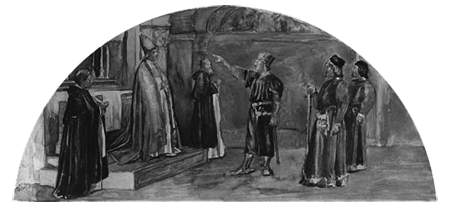
![]()

![]() Also Duke of Narbonne, Count of Quercy, Rouergue and Saint-Gilles;
Count of Agen (Aquitaine); Marquis of Provence (Holy Roman
Empire) Count of Melgueil (Papacy).
Also Duke of Narbonne, Count of Quercy, Rouergue and Saint-Gilles;
Count of Agen (Aquitaine); Marquis of Provence (Holy Roman
Empire) Count of Melgueil (Papacy).
Raymond's mother, Constance, was daughter of the king of France.
Raymond VI was count of Toulouse from 1194 to 1222. Son of Raymond V and Constance, sister of King Louis VII of France, he succeeded his father in 1194. He immediately re-established peace with the Kingdom of Aragon and his Trencavel cousins.

![]() Up
until Raymond's reign the House of Toulouse had been in
contention with the Kings
of England. At the root of the problem was the fact
that Henry
II and then
Richard I were Dukes of Aquitaine (through Eleanor
of Aquitaine, Henry's wife and Richard's mother) and
as such they claimed the County of Toulouse as an appenage.
The Counts regarded themselves as independent and had always
successfully played off the Dukes
of Aquitaine, and the Kings of France and Aragon against
each other to maintain that independence. In 1195 Richard
offered the hand of sister Jeanne
of England (sometimes called Joan) to Raymond VI. As
part of the deal Richard
renounced his claim to Toulouse and provided the County
of Agen as a dowry. Richard
himself presided over the marriage between Raymond and Jeanne,
giving her her full honorific from her first marriage, for
she was already dowager Queen of Sicily.
Up
until Raymond's reign the House of Toulouse had been in
contention with the Kings
of England. At the root of the problem was the fact
that Henry
II and then
Richard I were Dukes of Aquitaine (through Eleanor
of Aquitaine, Henry's wife and Richard's mother) and
as such they claimed the County of Toulouse as an appenage.
The Counts regarded themselves as independent and had always
successfully played off the Dukes
of Aquitaine, and the Kings of France and Aragon against
each other to maintain that independence. In 1195 Richard
offered the hand of sister Jeanne
of England (sometimes called Joan) to Raymond VI. As
part of the deal Richard
renounced his claim to Toulouse and provided the County
of Agen as a dowry. Richard
himself presided over the marriage between Raymond and Jeanne,
giving her her full honorific from her first marriage, for
she was already dowager Queen of Sicily.
Jeanne of England was Raymond's fourth wife. He was married six times. His wives were, in chronological order:
- Ermesinde, Countess of Melgueil. She had died in 1176 without issue.
- Beatrix de Carcassonne, whom he divorced in 1189. Raymond and Beatrix had one daughter: Constance of Toulouse, who would marry King Sancho VII of Navarre.
- Bourgogne, the daughter of King Amalric II of Jerusalem. Raymond divorced her in 1194.
- Jeanne of England (aka Joan Plantagenet) whom he married in October 1197 at Rouen. Their only surviving child would become Raymond VII (1197-1249), Count of Toulouse. Raymond VI's marriage to Jeanne made him son-in-law of Henry II and Eleanor of Aquitaine, and brother-in-law to Richard I (the Lionheart) and King John. (Jeanne was born in October, 1165. On 13 February 1177 she married William II, King of Sicily, and had issue. After William's death on 18 November 1189 she married Raymond VI in October 1196, fled in 1199 and died on 4 September 1199 at the Abbey of Fontevraud. By now a nun, she died in childbirth).
- a daughter of Isaac Comnenus of Cyprus, possibly called Beatrice. She had been taken from her father by King Richard I when he took Cyprus while on Crusade, and she had become the companion of Richard's wife Berengaria and his sister Jeanne of England (another wife of Raymond VII - see above). This marriage ended in divorce in 1202.
- Eleanor, daughter of King Alfonso II of Aragon and sister of King Peter of Aragon.
In Toulouse, Raymond VI maintained the city freedoms, extended exemptions from taxation, and extended his protection to the communal territory. A poet and a man of culture, he hated war but did not lack energy, as shown by his dispute with the papal legate Pierre de Castelnau. Pierre's assassination on January 15, 1208 led to Raymond's excommunication, and provided a suitable excuse for the first French Catholic Crusade against the Cathars of the Languedoc. The excommunication was lifted after Raymond humbled himself before the Pope.

![]() After
the capture of Béziers
and massacre there, the siege and capture of Carcassonne,
and the death of their Viscount, Raymond-Roger Trencavel, Raymond VI was again
put under pressure by the papacy, and was again excommunicated,
this time by the Council of Montpellier in 1211, when he
tried to organise resistance against the Albigensian
Crusade. More of a diplomat than a soldier, he was unable
to stop of the advance of Simon
de Montfort, who conquered Toulouse.
Raymond was exiled to England.
After
the capture of Béziers
and massacre there, the siege and capture of Carcassonne,
and the death of their Viscount, Raymond-Roger Trencavel, Raymond VI was again
put under pressure by the papacy, and was again excommunicated,
this time by the Council of Montpellier in 1211, when he
tried to organise resistance against the Albigensian
Crusade. More of a diplomat than a soldier, he was unable
to stop of the advance of Simon
de Montfort, who conquered Toulouse.
Raymond was exiled to England.
Raymond died while excommunicated and thus was denied a Catholic burial, though he he had been accepted into the ranks of the Knights Hospitalers shortly before he died.
Although Raymond VI is largely forgotten remembrances of his troubled rule are to be found in some unlikely places.
|
He is commemorated for his early contribution to civil rights and the idea of separation of Church and State. He is for example one of four figures painted on the ceiling of the Minnesota Supreme Court in the USA by John La Farge in 1903. He is shown in the company of Confucius, Socrates and Moses (other paintings), each representing an aspect of law. Raymond's painting is called "The Adjustment of Conflicting Interests", and accompanying text explains "The scene is of Raymond VI of Toulouse standing before the papal legate in 1208. Raymond argued successfully for city freedoms, extended exemptions from taxation, and protection of the communal territory from the church.". In this he was confirming privileges granted to the Capitouls of Toulouse by his father Raymond V, priveleges opposed by the Church because civic democracy in any form did not square with feudalism - which the Church then taught to be divinely sanctioned. |
|
Click on the following link for more on the
House of Toulouse ![]()
Click on the following link for more on Counts
of Toulouse ![]()
Click on the following link for more on the
the role of Raymond VI Count of Toulouse in the Cathar Crusade
![]()
Click on the following link for more about the
arms of fighters in the Cathar Wars 
|

 Raimon VI,
Raimon VI,  Raymond VI)
Raymond VI) 






